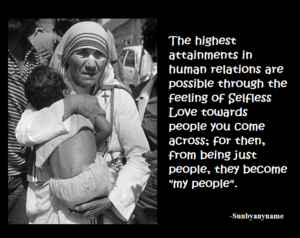Origins of Emotions and Relations
I find Human Evolution as a very fascinating subject. Humans or homo sapiens, as we see them around now, at some point of history of primates, separated themselves from the apes (hominids). Genetic studies bring out that the history of primates is older than 85 million years ago. There have been many theories (in the absence of recorded history we have either theories or gospel (word of mouth)) regarding the Evolution of Man, the foremost or the most accepted being the Darwinian theory. All these theories explore only the anatomical aspects; for example, the origin of man standing and walking on two feet and legs (bipedalism). Nothing has yet brought out the evolution of emotions and relationships, except in gospel. And that is the aspect that fascinates me most. For example, who was the first man or woman to fall in love? Or was it at the great ape stage or even earlier? When, how and why did the first man get angry and who triggered those emotions in him?
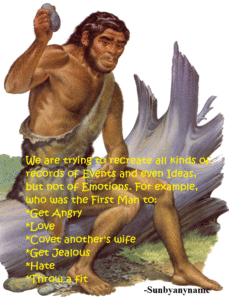
From emotions, relations and relationships are just the next logical steps, provided there has been some logic in evolution of these things. It is quite reasonable to assume that relations as we see them today have undergone dynamic changes in the thousands of years of evolution. Even if we believe gospel, for example, and assume that Adam and Eve were the only homo sapiens that were sent on Earth, their procreation, in terms of today’s relations would have produced only brothers and sisters. It would have stopped any further evolution of human-kind if they had considered procreation between brothers and sisters as sinful.
Family and Genes
It would be easy to consider that family and genes (both related to heredity) wouldn’t be exclusively human concepts. As humans, we are told (by sages and spiritual/religious leaders) that a feeling of I, My, Mine is the biggest obstacle that keeps us from true happiness and God (Sri Guru Granth Sahib refers to it as haume’) (Please read ‘Debatable Philosophies Of Life’). I had argued it out in the essay (that I have quoted above) that a feeling of myness is the most natural feeling in primates. No one needs to teach it even to apes and animals; they are naturally rejoicing in and protective of their progeny. So strong is this myness that it is imprinted on our genetic cells over generations; for example, we belong to a larger family having similarity of genes (heredity).
Even at that all-encompassing relationship of myness, it would be interesting to imagine the origin of specific familial relations, say, between father and son, husband and wife, uncles, aunts, brothers and sisters.
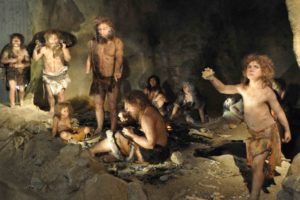
Blood Relations
Just as we have seen in the story of Adam and Eve, the concept of familial relations too has gone innumerable changes and modifications to arrive at the present accepted concept. The fact is that the present accepted concept is just a majority concept and is certainly not universal. In certain races or religions, for example, marriages are to take place within the family of blood relations only.
I have covered the concept of Religion and God in my essay ‘Whose God Is It Anyway?’ Lets, therefore, only ponder the concept of blood relations. It has become an important concept in legal circles and various tests are defined to prove blood relations. It would be easy to understand that the concept draws heavily from sexual reproduction (a physical phenomenon) and has nothing to do with one’s beliefs, biases and proclivities. Most often than not you don’t have to prove that you are brother and sister, mother and son, father and daughter. However, if inheritance, as seen by the law is at stake, you may have to prove that. It is another thing that at one time all of us may have belonged to one family. But, then, historically, as families became larger and larger, the concept of blood relations became narrower.
Human Relations Beyond Blood Relations
The fact is that increasingly human relations and relationships have become significantly more important than blood relations. One of the first ones to help propagate this concept was Lord Krishna. Even those who feel these tales are merely mythological (and have little historical basis), we are here talking about a concept that originated in India, which for the first time, more than 3000 years before Christ, made sacred a relationship beyond blood relation, even if forced by events or imagined events of that era. I am talking about the relationship between mother and child. Krishna was born to Devaki, the wife of Vasudeva. During the wedding of Krishna’s parents there was a prophecy that the eighth son of Devaki would kill the cruel Kansa. Since this prophecy was announced in the presence of Kansa (Devaki’s brother), he killed six sons that were born to Devaki. The seventh one Balarama escaped death by being transferred to the womb of Vasudeva’s other wife Rohini. Krishna escaped death by Vasudeva, his father, carrying him across Yanuna to his foster mother Yashoda (a wife of Nanda). In Hindu scriptures, Yashoda, the foster mother (not a blood relation) is far more important and revered than Devaki. In tales of Krishna-Leela, his childhood spent with Yashoda, is the most important period of episodic enchantment. Yes, this is not recorded history but gospel. However, this is the first time (even in folklore) that anyone called a relationship far more important than blood relation; the relationship of pure love that is.
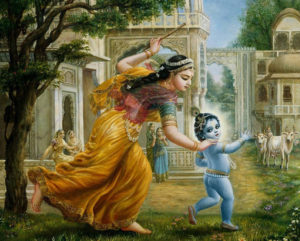
Two important things to note here are (whether or not it is historical) is that the concretisation of the concept of blood relations in later-day India and the legal wranglings to prove blood relations (for inheritance) have radically moved away from this concept. This is all the more ironical since the Law itself has been an evolution over centuries and not something writ in stone. And the other follows from the first one itself, which is that even those who believe in Krishna, move the courts to prove blood relations. Hence, religion is not a way of life all the way but merely a philosophy of convenience; we believe in some parts and ignore others that stand in the way of pragmatism.
Husband – Wife Relationship
In Hinduism there is no relationship more sacred than the one between Krishna and Radha; so much so that Radha Krishna is considered as one name rather than a combination of two. And yet, though the concept of marriage was prevalent in that period (such as Devaki marrying Vasudeva; Krishna’s parents, that is), Krishna and Radha never married.
Some four thousand years (or more) after Krishna was believed to have been born to Devaki and Vasudeva, the Sanskrit poet Jayadeva (recorded history) wrote a famous poem Gita Govinda in the 12th century AD, and then the spiritual love between Radha and Krishna became the subject of intense folklore. Hence whilst Krishna is shown not as deity but God Himself, Radha, His devotee, is shown as the embodiment of love by a devotee towards God. The Hindus raised this Love by Radhe as even more important than God Himself (Krishna). And that’s why it is always Radha Krishna or Radhe Krishna and never Krishna Radha.
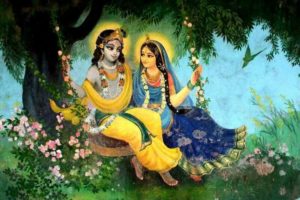
Human and God Relationship
The Adi Granth, the predecessor of present day Guru Granth Sahib, was compiled by the fifth Guru of the Sikhs – Guru Arjan Dev – in the sixteenth century. Thereafter, every Guru added something to it. The tenth and the last Guru, Guru Gobind Singh (whose name was one of the names of Krishna) didn’t add anything of his own but added all 115 hymns of his father Guru Teg Bahadur. In the year 1708, he decreed that after him there won’t be a human Guru but the Sikhs are to consider Guru Granth Sahib as their Guru.
The relationship between a devotee and God has been described in the Guru Granth Sahib by the first Guru – Guru Nanak – and curiously, it has drawn from the Radhe Krishna relationship: of between a wife and her husband. Guru Nanak portrayed the love of a suhagan (wife) for her husband as the purest form of devotion. He, of course, stressed upon the adornments for the suhagan being not material things like gold jewellery and diamonds but purity of heart and thoughts.
Take the case of Meerabai (born 1498). Meera Bai was born into a Rathore (Rajput) royal family of Kudki district of Pali, Rajasthan. Although born a princess, she renounced everything and became a devotee of Lord Krishna and considered herself married to Him. Since she flouted social and familial norms, she was persecuted by the society and especially by her in-laws. However, she didn’t desist from her chosen path. The Hindu scriptures, considering Devotee-God relationship as the one between wife and husband (Radhe Krishna), have widespread mention of the bhakti of Meera for Krishna as her husband, more than four thousand years after Krishna lived on earth.

Evolution of Modern Thought Process on Relations
Various rituals have been evolved over centuries to cement husband-wife relationship, the origin of all other familial relations.
The Saptapadi (Sanskrit for seven steps/feet), is the most important ritual of Vedic Hindu weddings, and represents the legal part of Hindu marriage. Sometimes called Saat Phere (seven rounds), couple conduct seven circuits of the Holy Fire (Agni), which is considered a witness to the vows they make to each other.
The Sikhs have Anand Karaj (blissful union introduced by Guru Amar Das (the third Guru) and involves four circuits around the Guru Granth Sahib (four lavan). Here God’s embodiment in the form of Guru Granth Sahib is considered witness to the holy marriage.
There are rituals in various other religions and castes most of them having some embodiment of God (such as agni, Guru Granth Sahib, Bible and other holy documents) as witness to the sacred marriage.
Guru Nanak, in his famous ‘Gagan mein thaal….’ arti in Jagannath Puri exhorted people to directly worship God (contained in His naam) rather than through any embodiment of God or deity (he refused to offer arti to Lord Krishna being only a deity when God Himself could be approached directly. Please read: ‘Nanak Shah Fakir – The Movie And Its Message‘). Curiously, this is one common element of all religions: they all know and feel that there is One God but the only real God is what they worship and all others are merely deities.
So the point is that the process of marriage is merely a ritual. Even if you want to make your marriage as sacred (marriages are, as is talked about in most religions and beliefs, made in heaven and then you are together for several lives (janam janam ka saath), merely chanting the name of God whilst accepting a person as your partner should be adequate for all purposes except for inheritance for which you have to legally prove your marriage.
Talking about dynamism or forever evolving concept of relationships, on the lighter side, in Mumbai (they must be elsewhere too) I have come across many couples whose male partners started off being Rakhi-Brothers (not blood brothers) (especially to widows) and who finally married their Rakhi Sisters.
Continuing with the lighthearted approach towards relations, I remember this anecdote of a divorced husband having to pay the bringing-up charges for his son (as part of alimony) until adulthood. On the first of every month, the son used to come calling at his blood father’s house, collect the alimony and go. On the first of a month just before the son’s 18th birthday, the father derisively told him, “Well, go back and tell your mother I am not your father anymore.” At this the son responded, “Mom wanted me to tell you that you never were”. Light-hearted alright, but that opens our eyes to the so called blood relations.
More and more people are now moving away from the religious rituals of weddings and for the purpose of legality of marriages for inheritance and other purposes getting married in courts (My son Arjun and daughter-in-law Samira did. Please read ‘Loveapalooza Arjun And Samira’s Lifetime Music Fest‘). Love is the strongest thread that need to be tied in order to complete the nuptials. Please recall that Guru Nanak, being a Hindu at that time, refused to wear the holy thread Janeyu as he said that no material symbols could replace oneness with God in thoughts.
Have the Hindi Movies Got it Right?
I am a fan and you would have seen it extensively in my blog posts. Whether or not the Hindi movies have got it right in other aspects of the movies, as far as evolution of relationships is concerned they seem to have kept pace and in many cases, several paces ahead.
Let me just give you three cases.
The first one is that of 1972 Shakti Samanta movie Amar Prem (Immortal Love) starring Rajesh Khanna and Sharmila Tagore. The film portrays the decline of human values and relationships (in blood relations, that is; Sharmila Tagore’s uncle sells her off as a courtesan) and contrasts it by presenting an outstanding example of a boy’s innocent love (Rajesh Khanna legally married to a wife who doesn’t care for him at all) for the same courtesan. A song about the decline of these relationships and double standards of people is a favourite of mine. It was penned by Anand Bakshi and composed by RD Burman in Raag Khammaj, Tal Kaherava. You must go through the lyrics in order to get the full meaning of these in the wake of discussions on relationships so far:
(kuchh to loga kahe.nge, logo.n kaa kaama hai kahanaa
chho.Do bekaara kii baato.n me.n kahii.n biita naa jaae rainaa ) – 2
kuchha to loga kahe.nge, logo.n kaa kaama hai kahanaa
kuchha riita jagata kii aisii hai, hara eka subaha kii shaama huii – 2
tU kauna hai, teraa naama hai kyaa, siitaa bhii yahaa.N badanaama huii
phira kyuu.N sa.nsaara kii baato.n se, bhiiga gaye tere nayanaa
kuchha to loga kahe.nge, logo.n kaa kaama hai kahanaa
chho.Do bekaara kii baato.n me.n kahii.n biita naa jaae rainaa
kuchha to loga kahe.nge …
hamako jo taane dete hai.n, hama khoe hai.n ina ra.ngaraliyo.n me.n – 2
hamane unako bhii chhupa chhupake, aate dekhaa ina galiyo.n me.n
ye sacha hai jhuuThii baata nahii.n, tuma bolo ye sacha hai naa
kuchha to loga kahe.nge, logo.n kaa kaama hai kahanaa
chho.Do bekaara kii baato.n me.n kahii.n biita naa jaae rainaa
kuchha to loga kahe.nge
The second one is this 1969 Asit Sen movie Khamoshi (Silence) starring Rajesh Khanna and Waheeda Rehman. She is a nurse in the hospital where he is admitted with mental disorder caused by having been deceived in love by his beloved he wanted to marry. This song penned by Gulzar and composed by Hemant Kumar says it all as far as relationships are concerned; it suggests that the only true relationships are those of love:
Hamane dekhii hai un aa.Nkho.n kii mahakatii Kushabuu
haath se chhuu ke ise rishto.n kaa ilzaam na do
sirf ehasaas hai ye ruuh se mahasuus karo
pyaar ko pyaar hii rahane do koii naam na do
hamane dekhii hai un aa.Nkho.n kii mahakatii Kushabuu
haath se chhuu ke ise rishto.n kaa ilzaam na do
hamane dekhii hai
Pyaar koii bol nahii.n, pyaar aavaaz nahii.n
ek Kaamoshii hai sunatii hai kahaa karatii hai
na ye bujhatii hai na rukatii hai na Thaharii hai kahii.n
nuur kii buu.Nd hai sadiyo.n se bahaa karatii hai
sirf ehasaas hai ye ruuh se mahasuus karo
pyaar ko pyaar hii rahane do koii naam na do
hamane dekhii hai un aa.Nkho.n kii mahakatii Kushabuu
haath se chhuu ke ise rishto.n kaa ilzaam na do
hamane dekhii hai
muskuraahaT sii khilii rahatii hai aa.Nkho.n me.n kahii.n
aur palako.n pe ujaale se jhuke rahate hai.n
ho.nTh kuchh kahate nahii.n, kaa.Npate ho.nTho.n pe magar
kitane Kaamosh se afasaane ruke rahate hai.n
sirf ehasaas hai ye ruuh se mahasuus karo
pyaar ko pyaar hii rahane do koii naam na do
hamane dekhii hai un aa.Nkho.n kii mahakatii Kushabuu
haath se chhuu ke ise rishto.n kaa ilzaam na do
hamane dekhii hai
Surprisingly, the third one that I am giving is also from a Rajesh Khanna movie: the 1971 Hrishikesh Mukherjee movie Anand (Bliss). The song in which the truth about relationships occurs was also sung by Hemant da in Bengali. Here, it was penned by Yogesh and composed by Salil Chowdhury. Here are very meaningful lines about relationships:
Kahii.n to ye, dil kabhii, mil nahii.n paate
Kahii.n se nikal aae, janamo.n ke naate
Love is the Greatest Relationship
Three months back I wrote an essay titled ‘Love – The Greatest Feeling On Earth‘. The relationship of Love is indeed the greatest relationship. And, it need not be between a husband and wife. Look at the relationship that a soldier has for the motherland (a son’s dedication for Bharat Mata). He is prepared to give his life for her and often does. There is a relationship of love between us and animals. Take this about our dog Roger and us:
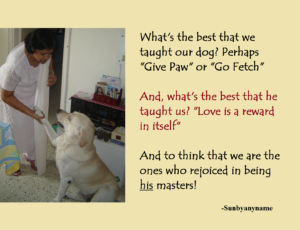
The most important relation or relationship is not by virtue of rituals and ceremonies but what a person actually means to you. Rituals and ceremonies are for societal and legal purposes, for example for inheritance. And why should inheritance be the consideration in relationships since after you are gone, you don’t own anything anymore? As Shakeel Badayuni wrote:
Yeh zindagi ke mele,
Duniya mein kam na honge,
Afsos ham na honge.
You can go narrower and narrower in relations and relationships. The fact is that every man is a variation of yourself and you are indeed related to every person on earth by the colour of his or her blood. If you want to seek more refinement in this God made relationship, you can seek a relationship of Love.
Today happens to be the canonisation of Mother Teresa. She is now onwards Saint Teresa of Calcutta. Here is the relationship that made that possible:
